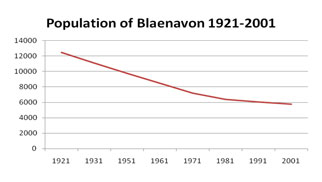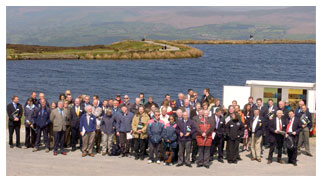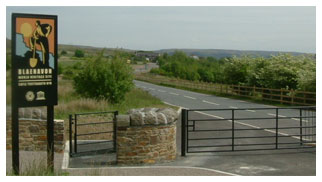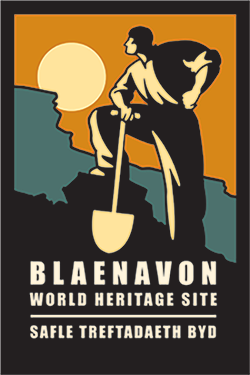Regeneration

Blaenavon’s economy never truly recovered from the turmoil of the Great Depression of the 1920s and 1930s. Despite various attempts to diversify the town’s economy in the years following the end of the Second World War, the town of Blaenavon, still largely reliant on the coal industry, continued to decline. As the British coal industry contracted in the late twentieth century, thousands of coalminers were made redundant throughout the country.
Blaenavon, like many coalfield towns, was unable to adapt to the changing economic situation and consequently it lost its purpose. The loss of industry resulted in a decline in population and by the end of the century Blaenavon’s increasingly aging population stood below 6,000 persons, less than half of what it was some eighty years before. The plight of the town was plain to see, the decayed dormitory town with its boarded up buildings epitomised the negative stereotype of a depressed post-industrial town.
Attempts had been made since the late 1960s to reverse the town’s decline but they tended to be piecemeal and only enjoyed limited or short-lived success. Importantly, however, Blaenavon Ironworks was placed under state protection in 1974 and Big Pit, Blaenavon’s last coalmine, was reopened as a museum in 1983. A gradual reappraisal of Blaenavon’s industrial heritage allowed for a heritage-led approach to tackling the economic problems of the town. Ambitious ideas and proposals were made throughout the 1980s to capitalise on tourism but a lack of impetus and commitment meant that the plans were not realised for many years.
The Blaenavon Project
Following Local Government reorganisation in 1996, the newly formed unitary authority, Torfaen County Borough Council, pledged to make the regeneration of Blaenavon a priority. In 1997 the Blaenavon Partnership was formed to provide a co-ordinated strategy to improve the town’s fortunes. The Partnership’s priority was to achieve UNESCO World Heritage Status for the town and this became a reality in November 2000. World Heritage Status did not bring with it any direct financial reward but the Partnership, led by Torfaen County Borough Council, has used the prestigious award as a catalyst to receive funding from various public bodies.
Tourism
Since 2000 a key priority has been the development of Blaenavon into a viable tourist attraction. Millions of pounds have been invested into the World Heritage Site to improve its tourism product. Big Pit, the Ironworks and the Pontypool and Blaenavon Railway have benefitted from improved historical interpretation and development in recent years. And two new tourist attractions, the Blaenavon Cordell and Community Heritage Museum and the Blaenavon World Heritage Centre were opened in 2001 and 2008 respectively, providing a deeper insight into the history of the town.

Outdoor Recreation
A greater appreciation of the picturesque and distinct landscape surrounding Blaenavon has been promoted since the 1990s with the opening of the Blaenavon Community Woodland, the Cycle Route and the completion of the Garn Lakes. Since 2000, however, a series of walks leaflets have been produced, including the flagship ‘Iron Mountain Trail’, which was launched in 2005. Ranger schemes have been implemented, allowing for local people to have a role in caring for the surrounding environment. Such initiatives have encouraged repeat visits to the town and have promoted healthy lifestyles. The Forgotten Landscapes Programme will also help conserve and interpret the countryside around the town.

Branding
The articulation of a unique and distinctive brand has been a major success. The Blaenavon Industrial Landscape World Heritage Site logo, designed by 6721 following public consultation, has been successfully used in marketing the World Heritage Site. The logo has been integrated into the Gateways project, which aims to provide clear and attractive entrances into Blaenavon.
Physical Regeneration
In 1997 a public consultation exercise found that the people of Blaenavon were ashamed of their town centre. There was very little to attract visitors to the unattractive, rundown town and it was also a depressing place for locals to live. Millions of pounds have been invested into the commercial and residential areas of Blaenavon in recent years, considerably enhancing the appearance and character of the town. The town centre was designated a conservation area in 1984 so a sympathetic restoration of the town’s buildings was necessary.
Derelict buildings such as the former Blaenavon Council Offices and the old St. Peter’s School have received extensive renovation and have been put to new use, serving in educational roles as the new Blaenavon Library and Blaenavon World Heritage Centre respectively. Property improvement grants have allowed for extensive repairs to people’s homes, whilst preserving or restoring the historic characteristics such as sash windows, chimney stacks, doors, letterboxes and traditional rendering. New houses built in and around the town have been built in character, ‘blending in’ with the older surrounding buildings.

The regeneration of Broad Street, the main commercial street, has followed a similar pattern. Extensive research, including the analysis of old photographs and the use of traditional building materials, has allowed for Broad Street to be transformed from ‘Plywood City’ to a bright mock-Victorian shopping centre. The local council has supported attempts from the private sector to bring new vitality to the town centre, including the Booktown Project launched in 2003. An assortment of new shops has opened alongside the more established businesses in recent years, including gift shops, cafes and a cheese shop.

Although heritage and historical accuracy have played a leading role in the formation of regeneration policy the implementation, in 2007, of an upward bound one-way traffic system was carried out in response to the challenges of a modern age. Broad Street, constructed in the days of horse and carts, was unsuitable for two way traffic and resulted in a congested and somewhat dangerous environment for pedestrians. The new road layout, including wider pavements and traffic calming measures, now provides a safer and friendlier pedestrian area.
Cultural Regeneration
Cultural activities such as the Spring Festival, World Heritage Day and the Garn Lakes Country Fayre have successfully attempted to bring people into the town. Such events also engage well with the local community. Community engagement and consultation have been central to many of the regeneration initiatives experienced in Blaenavon during the past decade. Many of the established local community groups and societies, such of the Townswomen’s Guild and the Male Voice Choir, have participated in local events. New groups, such as ‘Future Blaenavon’, have been formed. Blaenavon has also successfully utilised social and educational projects such as Communities First and the RISE Project.
In the decade since receiving World Heritage Status, the town of Blaenavon has enjoyed a successful period of urban and environmental regeneration. Although there have been some set-backs and some projects have proved less successful than others, the town has undoubtedly improved during the early years of the twenty-first century. There is still much work to be done in developing the World Heritage Site and maintaining the historic buildings. Global, national and local economic trends pose difficult challenges for local businesses but the town of Blaenavon, increased in confidence, is now well-prepared to face the future.

